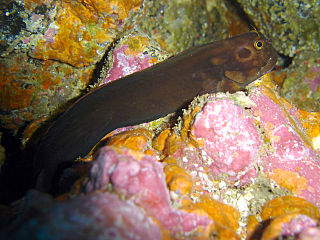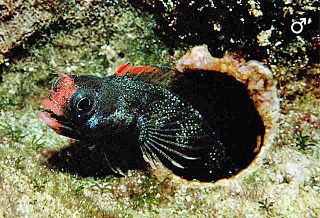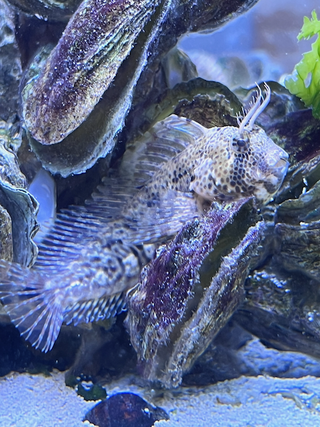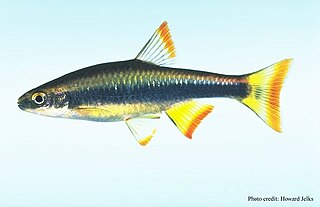
Combtooth blennies are blenniiformids; percomorph marine fish of the family Blenniidae, part of the order Blenniiformes. They are the largest family of blennies with around 401 known species in 58 genera. Combtooth blennies are found in tropical and subtropical waters in the Atlantic, Pacific and Indian Oceans; some species are also found in brackish and even freshwater environments.

Labrisomids are small blennioids (blennies), percomorph marine fish belonging to the family Labrisomidae. Found mostly in the tropical Atlantic and Pacific Ocean, the family contains about 110 species in 15 genera.

Enneanectes is a genus of triplefin fish in the family Tripterygiidae.

Coralliozetus is a genus of chaenopsid blennies mostly found in the eastern Pacific Ocean with one species (C. cardonae) occurring in the western Atlantic Ocean. Additionally, one species (C. clausus) is endemic to Cocos Island, Costa Rica.

Ophioblennius is a genus of combtooth blennies native to the Atlantic and to the Pacific coasts of the Americas.

Ecsenius is a large genus of fish in the family Blenniidae. Several species, including Ecsenius midas, the Midas blenny, and Ecsenius bicolor, the bicolor blenny, are commonly sold at aquarium stores as pets.

Acanthemblemaria is a genus of chaenopsid blennies native to the Atlantic and Pacific Oceans.

Hypsoblennius is a genus of combtooth blennies found in the Pacific and Atlantic Oceans.

Emblemariopsis is a genus of flagblennies found throughout the Atlantic ocean.
Emblemaria australis is a species of chaenopsid blenny known from around Brazil, in the southwestern Atlantic ocean. Females of this species can reach a maximum length of 2.7 centimetres (1.1 in) SL.
Emblemaria caldwelli, the Caribbean blenny, is a species of chaenopsid blenny found in coral reefs around the Bahamas, Belize, Honduras and Jamaica, in the western central Atlantic ocean. The specific name honours David K. Caldwell, Director of Marineland Research Laboratory, St. Augustine, Florida in gratitude for the loan of specimens.
Emblemaria hudsoni is a species of chaenopsid blenny found around Peru, in the southeast Pacific ocean. It can reach a maximum length of 7.4 centimetres (2.9 in) TL. The specific name honours the Captain Charles Bradford Hudson (1865-1939) of the District of Columbia National Guard, who was an illustrator and who painted many species of American fishes.
Emblemaria hypacanthus, the Gulf signal blenny, is a species of chaenopsid blenny known from the Gulf of California, in the eastern central Pacific ocean. It can reach a maximum length of 5 centimetres (2.0 in) TL. This species feeds primarily on zooplankton.
Emblemaria piratica, the sailfin signal blenny, is a species of chaenopsid blenny found from southern Mexico to Panama, in the eastern central Pacific ocean. It can reach a maximum length of 4 centimetres (1.6 in) TL. This species feeds primarily on zooplankton.
Emblemaria piratula, the pirate blenny, is a species of chaenopsid blenny found in coral reefs in the western central Atlantic ocean. It can reach a maximum length of 5 centimetres (2.0 in) TL. It is also found in the aquarium trade.

Paraclinus is a genus of labrisomid blennies native to eastern Pacific Ocean and the western Atlantic Ocean.

Starksia is a genus of labrisomid blennies native to the western Atlantic Ocean and the eastern Pacific Ocean. Their typical length is 2 cm (0.79 in) SL. The generic name honours the American ichthyologist Edwin Chapin Starks (1867-1932) of Stanford University for his work on Pacific coastal fishes. As a genus Starksia is distinguished from other labrisomids by their scaled bodies, two obvious soft rays in the pelvic fin and the male's have an intromittent organ which is near to or attached to the first spine of their anal fins, which is also somewhat separated from the fin.

Pteronotropis is a genus of cyprinid fish endemic to the United States.

Bollmannia is a genus of gobies native to the Atlantic and Pacific coasts of the Americas. The generic name honours the American naturalist Charles Harvey Bollman (1868–1889).

Microgobius is a genus of gobies native to the Pacific and Atlantic coasts of the Americas.














